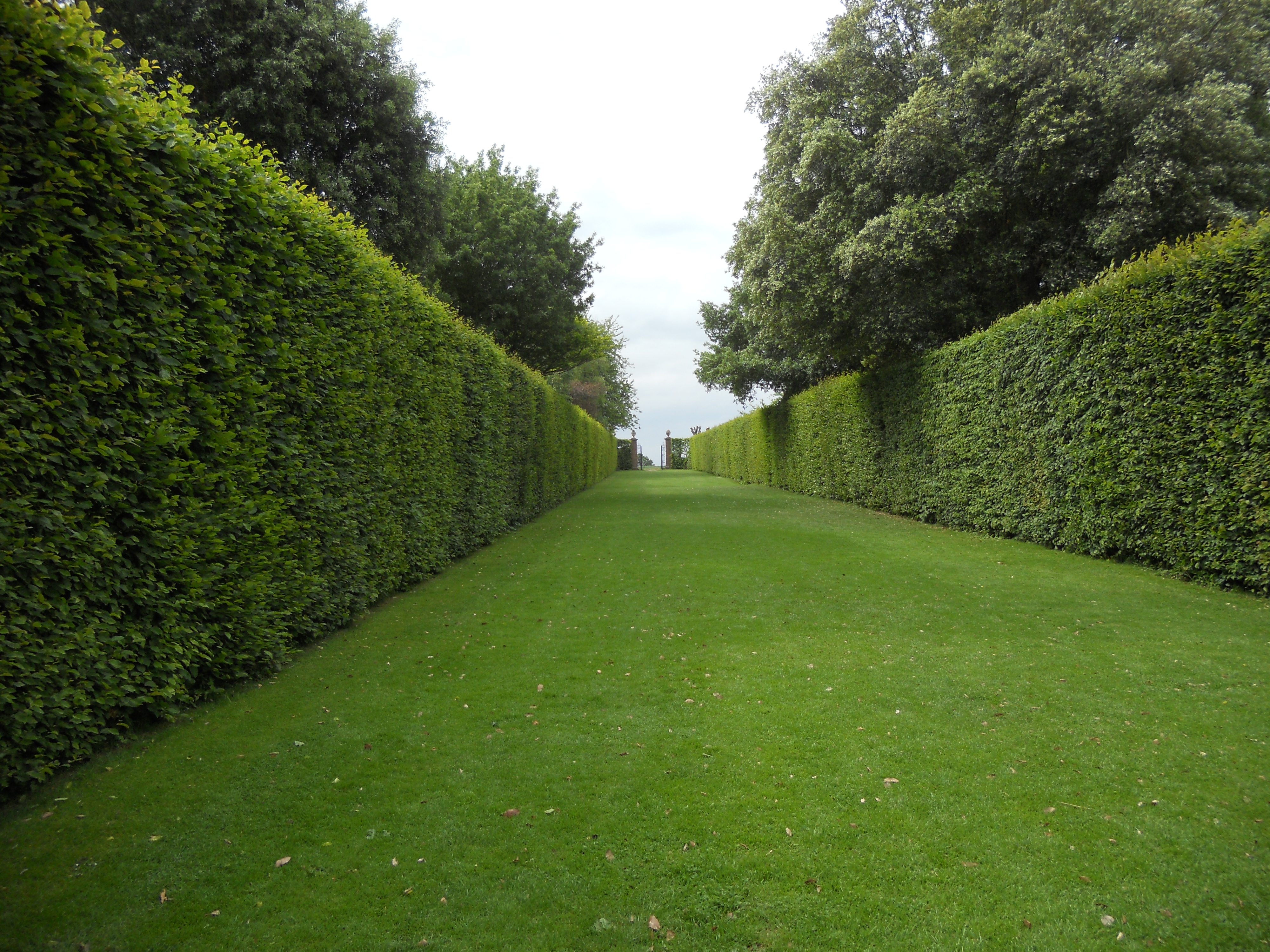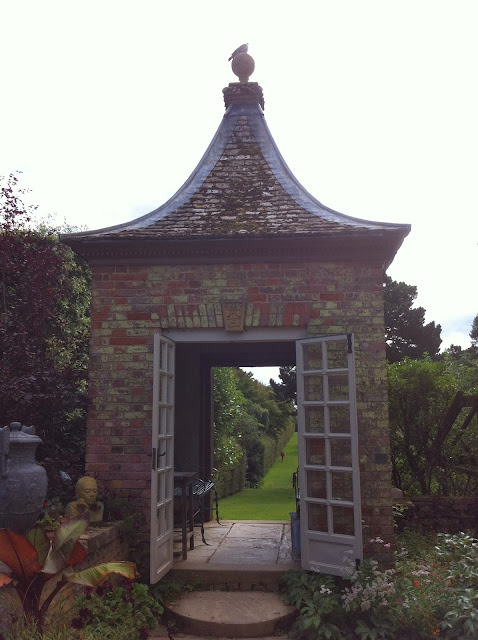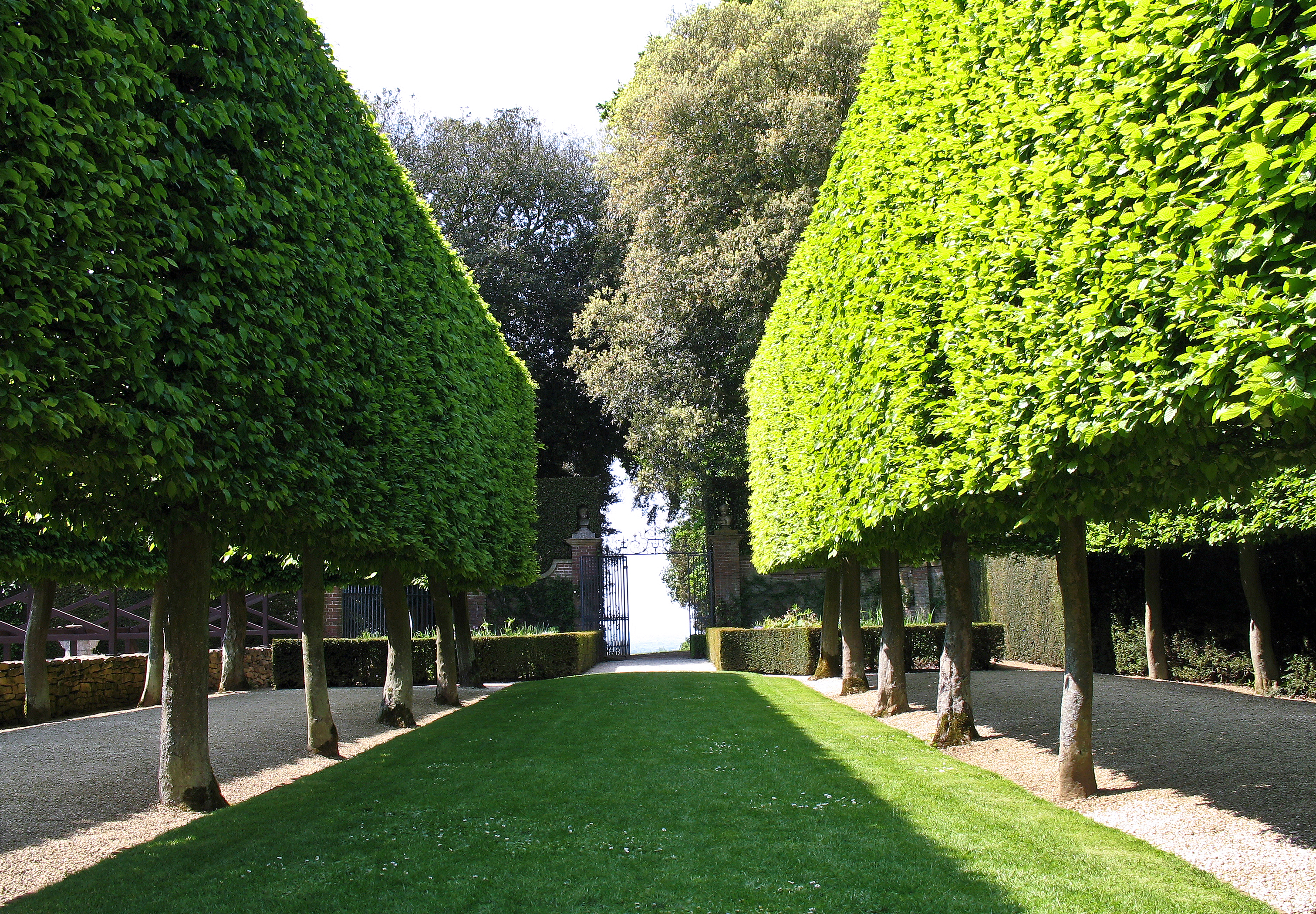Monday, October 14, 2013
Back to the Cradle - Exploring Kiftsgate Court Gardens
Sitting at the end of Hidcote's driveway, but light years away in style and atmosphere, is Kiftsgate Court Gardens. If Hidcote shouts, then Kiftsgate whispers. Both gardens share a stunning view of the vale of Evesham, but you'll find no grand displays of horticultural muscle here, instead you'll see gardening practiced at its highest level and on a human scale.
It is, without a doubt, a labor of love.
I first heard about Kiftsgate through its eponymous rose, mentioned in Rosemary Verey's books and which sent me on a not-so-successful search for species and old rose sources here in the United States. One thing led to another, and I stumbled across this charming video about Anne Chambers, her family, and the garden's journey from private sanctuary to public space.
As you enter the gravel drive you get the feeling you are attending a small private party. There is no fancy admission booth, just a card table set amongst a plant stall, within earshot of the tea room. With guide in hand, you turn the corner and you come upon Kiftsgate's signature, the Four Squares and Terrace. And while the choice of plants, their condition, and their presentation are impressive, what really strikes you is the superb relationship between the house and garden. This is the space that must have turned Heather Muir, the matriarch of Kiftsgate, into a gardener with ambition.
The tidy Kiftsgate guide book recommends a route through the garden that brings you through the Wide Border, the Sunk White Border, and into the Rose Border - home to the whacking big Kiftsgate Rose. All of these spaces are planted with care and are in harmony with the house and its environs.
It is when you reach the Water Garden that you realize that this is a garden with a special personality. Bounded on all four sides by a mature yew hedge, the space feels vaguely familiar. Certainly the water feature with its philodendron-molded leaves is new to you and, in fact, the garden itself is an unexpected contemporary piece set within a traditional English garden. So why is it so comfortable? And then it hits you, this is a tennis court, re-purposed as a garden room. Somewhere the balance of power between being a country house with a garden has shifted to being a garden that contains a country house. Kiftsgate charms because it sits right on this tipping point -- not quite public, not quite private.
You can just imagine the family, sitting around the breakfast table, hatching a plan for the new garden. "Well, we certainly don't play much tennis these days, and it would be nice to add a modern feel to the garden," one might say. "I have been thinking about commissioning something by Simon Allison, to go with the Simon Verity in the North Border," another might add. And it would be decided. No committee, no petitions, just a garden growing alongside its owners.
Reversing course, you head through the Yellow Border and down through the spectacular Scotch firs that frame the best view of the vale. Taking care along the narrow path, you arrive at a most well-placed small water feature (that I suspect doubles as a swimming pool for the family) perched on the hillside. The garden reaches its crescendo at this spot -- surrounded by a summer house and a folly -- with a fine view of the village of Mickleton.
I think that if you like a a gardener. you will like their garden; I certainly left Kiftsgate with affection for both. Everything about the place takes full advantage of its setting and although you know that a garden like this requires a steady stream of income, it doesn't feel too far removed your own experience. Money hasn't been thrown at every challenge, good taste and a measured pace has kept it human. Above all, Kiftsgate still has scope, opportunities to grow some century after it was started. And that is what we really wish for in all of our gardens.
Friday, October 11, 2013
Planting Potbound Boxwoods
Autumn is the time of year when every nursery looks to unload surplus inventory on unsuspecting gardeners. According to one stockist I use, "All the money is made in April and May -- by September we just hope to sell at wholesale." This makes it a great time to seek out those plants you need in quantity and gives you license to bargain hard with the end of the season on your side.
You can never have too many boxwood shrubs. And while I prefer the bog standard Buxus Sempervirens, I can always find a place for any of the Buxus Microphylla varieties in the garden. But you are always faced with a tough choice -- tiny twigs that you can afford, or proper, robust shrubs at a premium price. But the shortening days become a great equalizer, and the rows of $28, two-gallon "Green Beauty" plants drop to $18, and with some negotiation ("If I take all 25 plants, can we say $12 each?) you're in business.
But there is no such thing as a free lunch.
Hyped up on fertilizer and daily watering, each pot will be a tangled mass of tan, spidery roots, crowding out the potting medium and threatening the long-term health of the plant. It's good that its vigor also makes it bombproof.
Ruthless is the key word here, and as you brandish your razor knife you must "disguise fair nature with hard-favored rage", cutting out three deep v-shaped channels through the ball. This stops the encircling roots from strangling the plant, and prunes them so they immediately send out new shoots. Mixing well-rotted compost into the soil and breaking the backfill into a very crumbly tilth helps to ensure that as you water, the soil fills in around the rootball. I usually add a top layer of leaf mould, water twice per week for the next month, and add a bit of fertilizer in the spring.
We all know that there are no guarantees in gardening, but I've found this approach allows me to take advantage of the good deals that exist at the end of the gardening year.
Monday, October 7, 2013
Designing a Japanese-Style Garden - Part II, Foundation Plants and Hardscaping
The objective of this garden is to create a Japanese feel without resorting to any bridges or lanterns. I'm not looking down my nose at these, or saying that they are the same as garden gnomes, I just want to see if I can evoke the appropriate vibe in a nuanced way. Building on the plans I made in Designing a Japanese-Style Garden Part I, I moved from paper to ground.
The site has a huge advantage as it is on a hillside overlooking the pond. Water (or at least a view of water) seems essential to me, and having it in sight makes the creation of a more "introverted" fountain a matter of taste rather than necessity.
Last year I built the the retaining wall and the curving staircase.
The most awkward bit is a totally useless storm drain that, through several hurricanes and ten years, has never seen even a drop of water. But as in so many cases, this need to camouflage created one of the central features of the garden- the dry stream bed. . .
I was lucky to attend a nursery auction where I bought 25+ mature trees for little more than the price to have them moved. Several of these trees have ended up here. Including a fine prostrate Japanese Maple
At the top of the hill, standing nearly 25 feet tall, is an imposing Atlas Cedar (Cedrus atlantica). It required a 90" tree spade to move it and I spent the winter worrying about whether it would survive. So far, so good. . .
Mark Huf, owner of Huf Landscaping is one of my favorite people to deal with, and secreted away at the back of his nursery he had two eight-foot Japanese White Pines (Pinus parviflora) that, due to their position among a number of deciduous trees, had grown into interesting, windswept shapes. . .
Lining the curving staircase are sixteen Cherry Laurels (Prunus laurocerasus 'Otto Luyken'.) While not part of the traditional Japanese garden pallette, I think they fit the theme. . .
Maybe the most visually interesting plants are the two Umbrella Pines (Pinus densiflora 'Tanyosho'), leftover from another job and bought at a discount at Terrain. . .
Rising up just in side the staircase is a Crested Japanese Cedar (Cryptomeria japonica 'Cristata'), its branches forming the "hands" that make it a nice plant to view from up close.
With the foundational elements in place, it suddenly became much easier to envision the remaining shrubs and groundcovers that will tie the space together.
The site has a huge advantage as it is on a hillside overlooking the pond. Water (or at least a view of water) seems essential to me, and having it in sight makes the creation of a more "introverted" fountain a matter of taste rather than necessity.
Last year I built the the retaining wall and the curving staircase.
The most awkward bit is a totally useless storm drain that, through several hurricanes and ten years, has never seen even a drop of water. But as in so many cases, this need to camouflage created one of the central features of the garden- the dry stream bed. . .
I was lucky to attend a nursery auction where I bought 25+ mature trees for little more than the price to have them moved. Several of these trees have ended up here. Including a fine prostrate Japanese Maple
At the top of the hill, standing nearly 25 feet tall, is an imposing Atlas Cedar (Cedrus atlantica). It required a 90" tree spade to move it and I spent the winter worrying about whether it would survive. So far, so good. . .
Mark Huf, owner of Huf Landscaping is one of my favorite people to deal with, and secreted away at the back of his nursery he had two eight-foot Japanese White Pines (Pinus parviflora) that, due to their position among a number of deciduous trees, had grown into interesting, windswept shapes. . .
Lining the curving staircase are sixteen Cherry Laurels (Prunus laurocerasus 'Otto Luyken'.) While not part of the traditional Japanese garden pallette, I think they fit the theme. . .
Maybe the most visually interesting plants are the two Umbrella Pines (Pinus densiflora 'Tanyosho'), leftover from another job and bought at a discount at Terrain. . .
Rising up just in side the staircase is a Crested Japanese Cedar (Cryptomeria japonica 'Cristata'), its branches forming the "hands" that make it a nice plant to view from up close.
With the foundational elements in place, it suddenly became much easier to envision the remaining shrubs and groundcovers that will tie the space together.
Tuesday, October 1, 2013
Back to the Cradle- Exploring Hidcote Manor Garden
I just returned from a trip back to the UK where I visited three iconic gardens - Hidcote, Kiftsgate, and Sissinghurst - as they settled into their autumn colors. While I would have loved to visit many more, these hung together nicely as a group of gardens inspired by the vision of one person or family. Two are owned by the National Trust, and one thrives as its own private home. The curious thing is that each seemed to have something to teach me about my own little garden.
Hidcote Manor Gardens
Big and bold, Hidcote is the odd man out in this group. Created by the American, Lawrence Johnston in the early twentieth century, Hidcote oozes money and the confidence that it can inspire. The result is an impressive if slightly impersonal garden flexing its muscles above the vale of Evesham. I suspect that Johnston was neither the genius that the National Trust would have you believe, nor the villain you find in various books and documentaries. Needless to say that a brash American, spending his inheritance on a massive "English" Garden in the Cotswolds, will ruffle a few feathers
The first thing that strikes you about Hidcote is structure. Johnston had a great deal of space and he uses it to his advantage by creating a number of long axes (the plural of axis, not cutting tools!) The pleached limes lead you to a spectacular view of the Vale of Evesham.
As do the massive twin hedges that lead away from the gazebos that have come, in many ways, to define the garden.

Hidcote also tics all the boxes for a grand garden of its era - enormous country house, whacking big kitchen garden. . .
. . . Sculptures of beloved pets and domestic animals, and water features both large and small. The only thing missing is a large natural-ish body of water (along the lines of Blenheim or Stowe).
When I visit an important space like this I ask myself "What can I take away for my garden? And the use of sight lines seems to be key to Hidcote's success. I don't have the money, space, or imagination to raise my little patch above the level of "personal pleasure garden", but I do have one project, the formal (and proposed sunken garden) that could take some direction from Hidcote.
The gravel path is surrounded by two box-edged beds and leads to a step that is framed by two weeping redbuds. If I think like Hidcote and extend the visual line for about another fifty feet I can create the illusion of one continuous formal garden. If I really wanted to double down on the formality (and the budget), I could level this area (it is two feet higher near the steps) and create a sunken garden.
Maybe even use the space to install a Hidcote-like rectangular pond, create a full stop with a beech hedge and a focal point . . .
That all seems a little ambitious, and more than I will ever take on, but I suppose that is the danger of visiting gardens such as Hidcote.
Next up: A walk through Kiftsgate.
Subscribe to:
Posts (Atom)

























